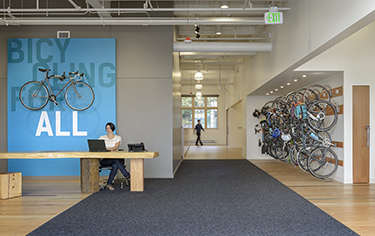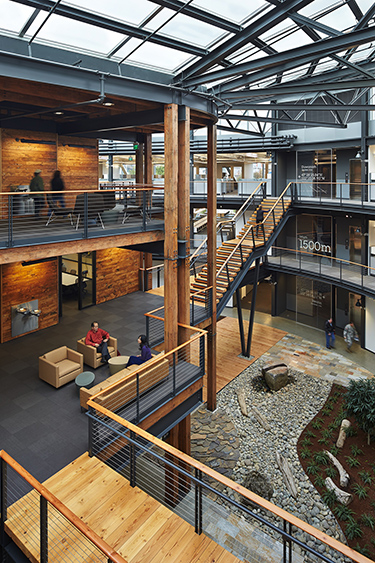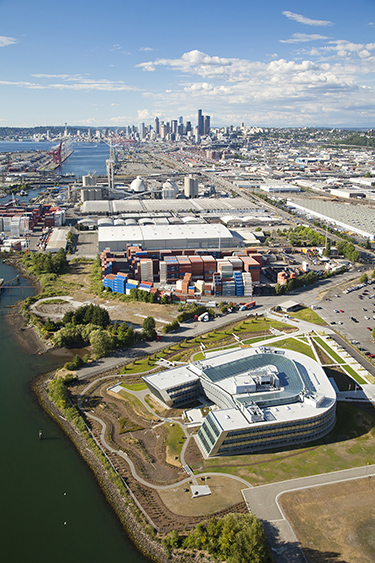|
Subscribe / Renew |
|
|
Contact Us |
|
| ► Subscribe to our Free Weekly Newsletter | |
| home | Welcome, sign in or click here to subscribe. | login |
Environment
| |
 |
March 23, 2017
4 strategies to make office workers healthier and more productive
ZGF Architects

Clark
|
Early sustainably designed buildings were largely seen as machines used to reduce energy and water consumption.
By examining current building energy codes and ever-increasing performance goals we can see that this mentality still exists. Although these efforts have been successful in reducing the environmental impact of buildings the importance of the building occupants’ well-being has sometimes been forgotten in the process.
People spend 90 percent of their time indoors on average. Twenty-five percent of that time is at work, totaling approximately 90,000 hours spent within the workplace in a lifetime. Therefore, it is important that these spaces be supportive or — even better — nurturing for employees’ bodies and minds. Furthermore, happy and healthy employees are more effective, and can significantly influence an organization’s bottom line and marketplace success.
How can we improve the quality of our workspaces? We can incorporate a number of occupant strategies into the design process, such as circadian lighting, biophilic design, healthy material choices, and active design. Rewards for building users can include improved health, wellness and productivity.
These strategies — while effective on their own — are strongest when combined and incorporated into an office’s design and work culture. Additionally, an employer’s commitment to provide their staff with an optimal environment is often reciprocated with increased dedication from the staff.
Circadian lighting
We often receive too little light during the day and too much light at night. These environmental cues can disrupt our internal body clocks, negatively affecting sleep cycles and leading to a number of poor long-term health outcomes.
Circadian lighting is a design solution that varies the color and intensity of lighting based upon the natural solar patterns. There are a variety of products available for the commercial and residential market that cater to the concept. For example, there are light fixtures that change color as well as applications that control the color and brightness of smartphones, tablets and screens based on location and time of day.
These lighting products are especially pertinent in the Pacific Northwest where winter days are short, daylight illumination levels are low, and supplementing daylight with electric lighting can be fruitful. In addition to maintaining the internal body clock, light exposure can also provide an alerting effect for post-noon drowsiness some employees may encounter.
Biophilic design
Biophilia literally means “love of nature.” Biophilic design leverages the intrinsic desire to be a part of nature, sets us at ease with our environment, and provides a gentle reminder of the passage of time and our place within the world. Other biophilic strategies include the use of natural or organic forms, and natural images and materials.
Biophilic design can be overt or subtle, as shown in two Seattle projects, Federal Center South Building 1202 and the behavioral health unit at Swedish Ballard.
Biophilic design strategies in Federal Center South, the headquarters for the Army Corps of Engineers, include its soft curvaceous form, abundant access to daylight and natural views, the use of natural materials and atrium plantings.
The design of the Swedish Ballard behavioral health unit is subtler, emulating movement through trees towards a bright clearing. The materials used reinforce the language of natural settings with a dark ground plane and light ceiling, vertical patterns that vary in density, and columns that dissolve as they ascend towards the sky. Lighting in the unit varies as the day progresses and supports the circadian systems of the patients and staff.
Healthy materials
Of the 82,000 chemicals registered with the U.S. Environmental Protection Agency, 85 percent of them have no health data and 67 percent have no data at all. This lack of information hinders our understanding of the impact building materials can have on environmental and human health.
History has also shown a significant time lag — years to decades — between the identification of a chemical’s health hazard and its subsequent regulation. However, there is hope.
The design community is demanding transparency from manufacturers, especially for the materials that occupants come in close contact with. Organizations such as the Health Product Declaration and Environmental Product Declaration have created transparency-reporting tools for manufacturers. Others like Mindful Materials and Seattle’s Healthy Materials Collaborative are gathering transparency information and pushing for market change through collaborative education and advocacy efforts.
Bolstered by recent research from Harvard’s T.H. Chan School of Public Health, designers know that air free of contaminants can increase cognitive function and reduce health risks. Armed with this knowledge they continue to push forward to get more healthy materials into the workplace.
Active design
Encouraging physical activity through workplace design can lead to improved health and happiness, and can be a mechanism to reinforce social and cultural ties. This idea, known as active design, encourages architectural design that invites people to make healthy choices.
For example, placing stairs in a prominent area of an office with an irresistible view makes climbing them a positive experience. Placing stairs in locations that make them the most obvious and efficient route from A to B is also ideal. Another example of active design include using sit-stand desks, as health consequences of long-term sitting has been referred to as the “new smoking.”
Building design can even influence how people get to work, and can improve occupant health. Providing quality end-of-trip bike facilities that are safe and support rider needs with showers and locker rooms will encourage employees to bike to work more often. Through active design the social and cultural opportunities of activities like biking can become the next generation of the office water cooler.
A paradigm shift is underway that places the occupant at the center of the design effort, and seeks to create nurturing environments that allow humans to thrive in the space they inhabit.
These shifts are not only good for people, but also good for business. Occupant strategies such as circadian lighting, biophilic design, healthy material choices, and active design can be readily included into the design process, rewarding building users with improved health and wellness and increased productivity.
Ed Clark is an associate partner at ZGF Architects.
Other Stories:
- 2 state bills would reward owners who green up their buildings
- How 'negawatts' help the building industry fight climate change
- Next frontier for sustainability? The people inside all those green buildings
- ‘Biophilic’ design bonds children with nature
- Eco-friendly transfer station adds playground to be a good neighbor
- Georgia Tech wants a Living Building, but can designers beat the heat?
- Sweat the details to make building green pay off
- 12 Bel-Red townhouses help restore a trashed site





